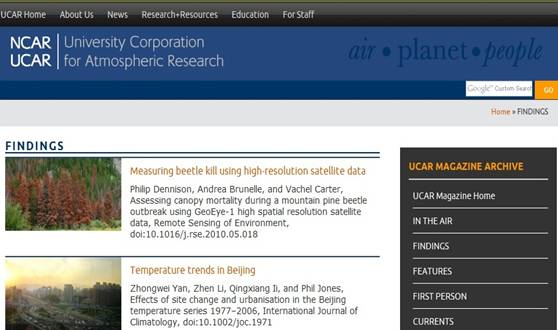Homogenization of climate observation series is essential for analyzing climate change and causes, especially for China, where meteorological stations experienced site-changes even in recent years. The present study is a typical example highlighting problems in current methods of homogenization of daily climate data and estimation of the urbanization effect in temperature observations. Data at a number of nearby stations, which became available recently, made possible a detailed study of the inhomogeneities induced by two recent site changes of Beijing Observatory (BJ), one in 1981 from its suburban to urban site and another in 1997 back to the suburban site, and enabled estimates of the potential urban-related warming bias to be made. Main conclusions are summarized as follows.
(1) The impacts induced by the two site changes could be recognized at a seasonal scale, while they could be overlooked at shorter timescales due to the large magnitude of weather variability. Note that many methods of homogenization are aimed at monthly adjustments. Differences of inter-annual climate variability among different stations were influential for calculating adjustments for seasonal temperature anomalies; hence a multiyear-mean adjustment variable was introduced and analyzed. It was suggested that 3 years of records before and after the relocation be considered in calculating the seasonal adjustments. However, if the applied overlapping period of the candidate series and the reference series around the break point is too long (e.g., longer than 5 years), the consequent adjustments could bias the long-term trend in the candidate series. Although the biases in the BJ records should be independent from other site records, a cluster of Core Reference Stations was chosen for estimation of the site-change-induced effects in order to lessen possible additional problems due to different weather and climate variability at individual sites. These findings are novel and can serve as guidelines for properly applying classical methods currently available and developing new methods of homogenization for daily climate observations.
(2) The absolute values of the site-change-induced impacts were larger for winter/spring (up to 0.95°C) than for summer/autumn (down to 0.43°C), featuring a typical UHI for Beijing with concentrated heating in cold seasons. The annual mean UHI effect around the site change in 1997 was 0.12°C smaller than that in 1981, implying a more enhanced urbanization growth at the suburban location than the central urban area during the 1981–1997 periods. The adjusted series exhibited a slightly enhanced long-term warming trend (0.78 vs 0.62°C/decade for the annual mean series during 1977–2006). By comparing the effects induced by the two site changes and with several rural and less-urban records back to 1965, the present authors suggested that the urban-related warming bias in the BJ temperature series was about 0.3°C/decade, comparing with the overall warming about 0.8°C/decade for the last 3-4 decades. Note that previous studies using unadjusted data used to conclude that most of the ‘observed’ warming at BJ could be due to urbanization. The present results have been highlighted as one of the ‘Findings’ in UCAR Magazine (August 2010). --Prof. Yan Zhongwei, TEA, IAP

